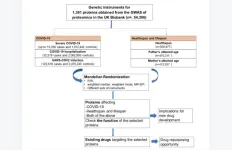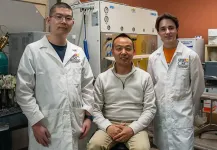(Press-News.org) Meta-analysis of genetic studies from 10 countries finds infants born by C-section have more antibiotic resistance genes; antibiotic use and prematurity also fuel resistance.
Infants living in Africa had more antibiotic resistant genes than those from Europe.
Findings indicate that interventions targeting the gut microbiome of mothers and their infants, such as probiotics, could help reduce antibiotic resistance spread.
**ECCMID has now changed name to ESCMID Global, please credit ESCMID Global Congress in all future stories**
A meta-analysis of genetic studies analysing the microbiota (bacteria in the gut) of 1,275 infants from 10 countries finds that caesarean delivery and antibiotic use are driving the increase of antibiotic resistance genes load among infants, according to new research being presented at this year’s ESCMID Global Congress (formerly ECCMID) in Barcelona, Spain (27-30 April).
The study, by researchers from UiT The Artic University of Norway, highlights the urgent need for more research on targeted interventions to reduce antibiotic resistance in infants. They speculate that probiotics, for example, could reduce the abundance of antibiotic resistance genes and merit further investigation [1].
Antimicrobial resistance (AMR) is a global health emergency. Drug-resistant infections kill more than 1.27 million people a year worldwide [2]. If no action is taken, antimicrobial resistance could overtake cancer as the leading cause of death worldwide by 2050, and is projected to kill 10 million people globally [3].
Infants are highly susceptible to infections due to their immature immune system. At the same time, their gut microbiota is full of diverse bacteria, many of which harbour resistance against a broad range of antibiotics, even in the absence of antibiotic exposure. The gut resistome—the collection of antibiotic resistant genes (ARGs) harboured in the genomes of infant gut microbes—develops when microbes flood the gut immediately after birth, and is an important piece of the AMR puzzle.
The gut mobilome—the collection of diverse mobile genetic elements (MGEs) within the gut, plays a key role in the spread of ARGs. Bacteria swap genetic material, like ARGs, through horizontal gene transfer. With so many bacteria in close proximity, the gut provides ideal conditions for this exchange of ARGs.
While many intestinal bacteria harbouring ARGs do not pose a health threat, some ARGs are acquired by microbes with pathogenic potential. When these genes are transmitted to a pathogen, this has dire consequences for both the individual patient and society.
Understanding the factors influencing the development of the infant gut resistome and mobilome is therefore crucial for developing strategies to mitigate AMR prevalence.
Several previous clinical studies have provided important but fragmented insights into the gut resistome, but their small sample sizes and inherent biases (e.g., selection bias and confounding) limit the generalisability of the findings.
To overcome these limitations, researchers conducted a meta-analysis of infant cohorts based on metagenomics data from 14 studies spanning 10 countries and three continents.
They investigated the extent to which antibiotic use, birth mode, prematurity, feeding practices, and geography influenced the abundance and diversity of ARGs and MGEs in 3,981 gut metagenome faecal samples from 1,275 infants. To track the infants’ microbiomes, infants’ stools were sampled longitudinally up to 14 months of age.
Researchers used published shotgun metagenomes (untargeted genetic sequencing of all bacteria living in the gut) to examine the associations between the diversity and load of ARGs and MGEs and antibiotic use, birth mode, prematurity, feeding practices, and geography, as well as to identify which bacterial species are major hosts of ARGs within infants’ gut.
Overall, the analyses found that use of antibiotics, Caesarean delivery, and prematurity was significantly associated with reduced beneficial gut microbe diversity compared to full-term, vaginally-born infants not exposed to antibiotics.
On the other hand, vaginal birth was linked to lower abundance but more diverse ARGs compared to C-section delivery.
“Vaginally born infants are exposed to more vaginal and gut bacteria compared to C-section born babies, who are primarily exposed to skin bacteria,” explains lead author Ahmed Bargheet from UiT The Artic University of Norway. “Since bacteria correlate with the collection of antibiotic resistant genes in the gut, higher antibiotic resistant gene diversity in vaginally born infants is expected. However, the presence of higher levels of certain commensal bacteria—which supply their host with essential nutrients and help defend the host against opportunistic pathogens—in vaginally born infants may suppress pathogenic bacteria (which are likely to carry a higher abundance of antibiotic resistant genes), thereby reducing the overall abundance.”
As expected, the analyses found that antibiotic use was linked to higher ARG and MGE abundance. However, antibiotic use had no significant impact on the ARGs’ diversity.
Surprisingly, exclusively breastfed infants showed no significant effects on ARG diversity or abundance.
Importantly, the researchers detected 199 clinically relevant ARGs (that confer resistance to clinically relevant antibiotics), whose diversity increased with age during the first two years of life. “The diversity of the ARGs increased over time, mirroring the diversity of the bacteria. However, the abundance of ARGs decreased over time, possibly due to a reduction in the abundance of pathogenic bacteria such as Escherichia coli”, says Bargheet.
Interestingly, two African cohorts (from Zimbabwe and South Africa) had a statistically significant and higher ARG and MGE abundance compared to the European cohorts. “It’s possible that Zimbabwe and South Africa used more antibiotics in their infant cohorts than the Europeans”, says Bargheet. “In Zimbabwe, the regulation and control of antibiotics is not as strict as in some regions of Europe, leading to a situation where antibiotics can often be purchased over the counter without a prescription, potentially exacerbating antimicrobial resistance.”
The authors further confirmed E. Coli as the main host of ARGs in the guts of infants, and concerningly, nearly half of the ARGs co-localised with plasmids, allowing efficient transfer between bacteria. Furthermore, E. coli strain diversity was found to be reduced during breastfeeding, but increased with age. Interestingly, antibiotic use had no significant impact on the E. coli strain diversity.
“Our meta-analysis of the available evidence clearly shows that C-section delivery, antibiotic use, and prematurity play an underappreciated role in antibiotic resistance in infants by altering early life resistome and mobilome, leading to an increased gut carriage of antibiotic resistance genes and mobile genetic elements”, says Bargheet.
“This has important implications for the antibiotic resistance crisis. By gaining insight into these factors, we aim to develop targeted interventions like probiotics, that could significantly reduce the number of deaths caused by antimicrobial resistance. This research not only addresses a pressing global health challenge but also sets the stage for breakthroughs in medical treatment and infection control. As we move forward, our focus remains on turning these findings into actionable strategies that can save lives and curb the spread of resistant infections.”
Despite the important findings, the authors note several limitations, including that the impact of hospitalisation and other clinical variables could not be examined in this analysis due to a lack of data.
END
Major genetic meta-analysis reveals how antibiotic resistance in babies varies according to mode of birth, prematurity, and where they live
Meta-analysis of genetic studies from 10 countries finds infants born by C-section have more antibiotic resistance genes; antibiotic use and prematurity also fuel resistance.
2024-04-25
ELSE PRESS RELEASES FROM THIS DATE:
Q&A: How TikTok’s ‘black box’ algorithm and design shape user behavior
2024-04-24
TikTok’s swift ascension to the upper echelons of social media is often attributed to its recommendation algorithm, which predicts viewer preferences so acutely it’s spawned a maxim: “The TikTok algorithm knows me better than I know myself.” The platform’s success was so pronounced it’s seemed to spur other social media platforms to shift their designs. When users scroll through X or Instagram, they now see more recommended posts from accounts they don’t follow.
Yet for all that influence, the public knows little about how TikTok’s ...
American Academy of Arts and Sciences elects three NYU faculty as 2024 fellows
2024-04-24
The American Academy of Arts and Sciences has elected three New York University faculty as 2024 fellows: Glennys R. Farrar, a professor in the Department of Physics; André A. Fenton, a professor and chair of the Center for Neural Science; and Rachel L. Swarns, a professor in the Arthur L. Carter Journalism Institute.
“We honor these artists, scholars, scientists, and leaders in the public, non-profit, and private sectors for their accomplishments and for the curiosity, creativity, and courage required ...
A closed-loop drug-delivery system could improve chemotherapy
2024-04-24
When cancer patients undergo chemotherapy, the dose of most drugs is calculated based on the patient’s body surface area. This is estimated by plugging the patient’s height and weight into an equation, dating to 1916, that was formulated from data on just nine patients.
This simplistic dosing doesn’t take into account other factors and can lead to patients receiving either too much or too little of a drug. As a result, some patients likely experience avoidable toxicity or insufficient benefit from the chemotherapy they receive.
To make chemotherapy dosing more ...
MIT scientists tune the entanglement structure in an array of qubits
2024-04-24
Entanglement is a form of correlation between quantum objects, such as particles at the atomic scale. This uniquely quantum phenomenon cannot be explained by the laws of classical physics, yet it is one of the properties that explains the macroscopic behavior of quantum systems.
Because entanglement is central to the way quantum systems work, understanding it better could give scientists a deeper sense of how information is stored and processed efficiently in such systems.
Qubits, or quantum bits, are the building blocks of a quantum computer. However, it is extremely difficult to make specific entangled states in many-qubit ...
Geologists discover rocks with the oldest evidence yet of Earth’s magnetic field
2024-04-24
Geologists at MIT and Oxford University have uncovered ancient rocks in Greenland that bear the oldest remnants of Earth’s early magnetic field.
The rocks appear to be exceptionally pristine, having preserved their properties for billions of years. The researchers determined that the rocks are about 3.7 billion years old and retain signatures of a magnetic field with a strength of at least 15 microtesla. The ancient field is similar in magnitude to the Earth’s magnetic field today.
The open-access findings, appearing ...
It’s easier now to treat opioid addiction with medication -- but use has changed little
2024-04-24
For years, even as opioid overdose deaths dramatically increased, doctors and other prescribers in the United States needed special permission from the federal government if they wanted to prescribe buprenorphine, a medication that helps patients overcome opioid addiction and prevents fatal overdoses.
That requirement, called an “X waiver”, was eliminated on January 12, 2023 due to an item in a major federal budget bill. This meant that suddenly, any clinician who had a license to prescribe controlled substances could prescribe ...
Researchers publish final results of key clinical trial for gene therapy for sickle cell disease
2024-04-24
Philadelphia, April 24, 2024 – In a landmark study, an international consortium led by researchers at Children’s Hospital of Philadelphia (CHOP) published the final results of a key clinical trial of the gene therapy CASGEVY (exagamglogene autotemcel) for the treatment of sickle cell disease in patients 12 years and older with recurrent vaso-occlusive crises (VOCs). The study found that 96.7% of patients in the study did not have any vaso-occlusive crises (VOCs) – a blockage that results in lack of oxygen and painful episodes – for at least one year, and 100% were able to remain hospitalization-free for the same ...
Identifying proteins causally related to COVID-19, healthspan and lifespan
2024-04-24
“[...] we identified multiple proteins affecting COVID-19 and aging.”
BUFFALO, NY- April 24, 2024 – A new research paper was published in Aging (listed by MEDLINE/PubMed as "Aging (Albany NY)" and "Aging-US" by Web of Science) Volume 16, Issue 7, entitled, “Using genetics and proteomics data to identify proteins causally related to COVID-19, healthspan and lifespan: a Mendelian randomization study.”
The COVID-19 pandemic poses a heavy burden on public health and accounts for substantial mortality and morbidity. Proteins are building blocks of life, but specific proteins causally related ...
New study reveals how AI can enhance flexibility, efficiency for customer service centers
2024-04-24
BINGHAMTON, N.Y. -- Whenever you call a customer service contact center, the team on the other end of the line typically has three goals: to reduce their response time, solve your problem and do it within the shortest service time possible.
However, resolving your problem might entail a significant time investment, potentially clashing with an overarching business objective to keep service duration to a minimum. These conflicting priorities can be commonplace for customer service contact centers, which often rely on the latest technology to meet customers’ ...
UT School of Natural Resources team receives grant to remove ‘forever chemicals’ from water
2024-04-24
Mi Li, assistant professor in the University of Tennessee Center for Renewable Carbon and the UT School of Natural Resources, received a $75,000 research grant from the U.S. Environmental Protection Agency (EPA) for a two-year project using a cellulose-functionalized adsorbent to remove per- and polyfluoroalkyl substances (PFAS) from water. Li has built a student team to work on this project including Kailong Zhang, a Ph.D. student in the School of Natural Resources, and Ryan Baskette, an undergraduate student in the Department of Biochemistry and Cellular and Molecular Biology.
The grant comes from the EPA’s People, Prosperity, and the Planet Program, which provided almost ...
LAST 30 PRESS RELEASES:
General intelligence framework to predict virus adaptation based on a genome language model
Antibiotic resistance is ancient, ecological, and deeply connected to human activity, new review shows
Vapes, pouches, heated tobacco, shisha, cigarettes: nicotine in all forms is toxic to the heart and blood vessels
From powder to planet: University of Modena engineers forge a low-carbon future for advanced metal manufacturing
Super strain-resistant superconductors
Pre-school health programme does not improve children’s diet or physical activity, prompting call for policy changes, study finds
Autumn clock change linked to reduction in certain health conditions
AI images of doctors can exaggerate and reinforce existing stereotypes
Where medicine meets melody – how lullabies help babies and parents in intensive care
We may never be able to tell if AI becomes conscious, argues philosopher
AI video translation shows promise but humans still hold the edge
Deep ocean earthquakes drive Southern Ocean’s massive phytoplankton blooms, study finds
Without campus leftovers to pick through, the beaks of this bird changed shape during the pandemic
High-dose antibiotic does not reduce mortality in tuberculous meningitis
How many insects fly in the sky above the USA?
Could cheese protect your brain health?
Who faces more difficulty recovering from stroke?
Colliding galaxies create the brightest, fastest growing black holes at their center
New BrainHealth research reveals tradeoffs on sleep with cannabis use for chronic pain
Aging-US now on ResearchGate, enhancing visibility for authors and readers
'Molecular glue' stabilizes protein that inhibits development of non-small cell lung cancer
Mount Sinai Health System is recognized in 2025 Chime Digital Health Most Wired survey
From prey to predator: How carnivores spread beneficial fungi
Menopause symptoms may be frequent and have negative effects, according to female endurance athletes
US Congressmembers’ responses on X to mass shooting events differ along party lines
KAIST-UEL team develops “origami” airless wheel to explore lunar caves
Individual genetic differences render some therapies ineffective
Engineering dendritic cells boosts cancer immunotherapy
Sophisticated neuroimaging reveals PTSD in WTC responders is linked to measurable physical changes in brain structure
Health policy experts identify promising strategies for providing health care to homeless people
[Press-News.org] Major genetic meta-analysis reveals how antibiotic resistance in babies varies according to mode of birth, prematurity, and where they liveMeta-analysis of genetic studies from 10 countries finds infants born by C-section have more antibiotic resistance genes; antibiotic use and prematurity also fuel resistance.



